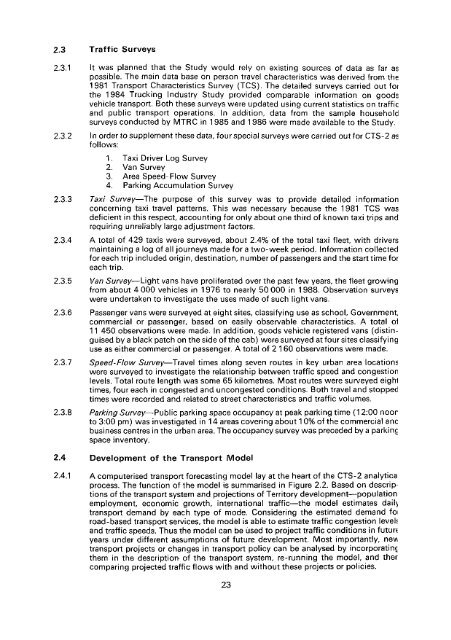Untitled - HKU Libraries - The University of Hong Kong
Untitled - HKU Libraries - The University of Hong Kong
Untitled - HKU Libraries - The University of Hong Kong
- No tags were found...
Create successful ePaper yourself
Turn your PDF publications into a flip-book with our unique Google optimized e-Paper software.
2.3 Traffic2.3.1 It was planned that the Study would rely on existing sources <strong>of</strong> data as far aspossible. <strong>The</strong> main data base on person travel characteristics was derived from the1981 Transport Characteristics Survey (TCS). <strong>The</strong> detailed surveys carried out forthe 1984 Trucking Industry Study provided comparable information on goodsvehicle transport. Both these surveys were updated using current statistics on trafficand public transport operations. In addition, data from the sample householdsurveys conducted by MTRC in 1 985 and 1 986 were made available to the Study.2.3.2 In order to supplement these data, four special surveys were carried out for CTS-2 asfollows:1. Taxi Driver Log Survey2. Van Survey3. Area Speed-Flow Survey4. Parking Accumulation Survey2.3.3 Taxi Survey—<strong>The</strong> purpose <strong>of</strong> this survey was to provide detailed informationconcerning taxi travel patterns. This was necessary because the 1981 TCS wasdeficient in this respect, accounting for only about one third <strong>of</strong> known taxi trips andrequiring unreliably large adjustment factors.2.3.4 A total <strong>of</strong> 429 taxis were surveyed, about 2.4% <strong>of</strong> the total taxi fleet, with driversmaintaining a log <strong>of</strong> all journeys made for a two-week period. Information collectedfor each trip included origin, destination, number <strong>of</strong> passengers and the start time foreach trip.2.3.5 Van Survey—Light vans have proliferated over the past few years, the fleet growingfrom about 4000 vehicles in 1976 to nearly 50000 in 1988. Observation surveyswere undertaken to investigate the uses made <strong>of</strong> such light vans.2.3.6 Passenger vans were surveyed at eight sites, classifying use as school Governmentcommercial or passenger, based on easily observable characteristics. A total ol11 450 observations were made. In addition, goods vehicle registered vans (distinguisedby a black patch on the side <strong>of</strong> the cab) were surveyed at four sites classifyinguse as either commercial or passenger. A total <strong>of</strong> 2 160 observations were made.2.3.7 Speed-Flow Survey—-Travel times along seven routes in key urban area locationswere surveyed to investigate the relationship between traffic speed and congestionlevels. Total route length was some 65 kilometres. Most routes were surveyed eighltimes, four each in congested and uncongested conditions. Both travel and stoppedtimes were recorded and related to street characteristics and traffic volumes.2.3.8 Parking Survey—Public parking space occupancy at peak parking time (12:00 noonto 3:00 pm) was investigated in 14 areas covering about 10% <strong>of</strong> the commercial ancbusiness centres in the urban area. <strong>The</strong> occupancy survey was preceded by a parkingspace inventory.2.4 Development <strong>of</strong> the Transport Model2.4.1 A computerised transport forecasting model lay at the heart <strong>of</strong> the CTS-2 analyticaprocess. <strong>The</strong> function <strong>of</strong> the model is summarised in Figure 2.2. Based on descriptions<strong>of</strong> the transport system and projections <strong>of</strong> Territory development—populationemployment economic growth, international traffic—the model estimates dail^transport demand by each type <strong>of</strong> mode. Considering the estimated demand foiroad-based transport services, the model is able to estimate traffic congestion levelsand traffic speeds. Thus the model can be used to project traffic conditions in futureyears under different assumptions <strong>of</strong> future development. Most importantly, nev\transport projects or changes in transport policy can be analysed by incorporatingthem in the description- <strong>of</strong> the transport system, re-running the model, and thercomparing projected traffic flows with and without these projects or policies.23
















